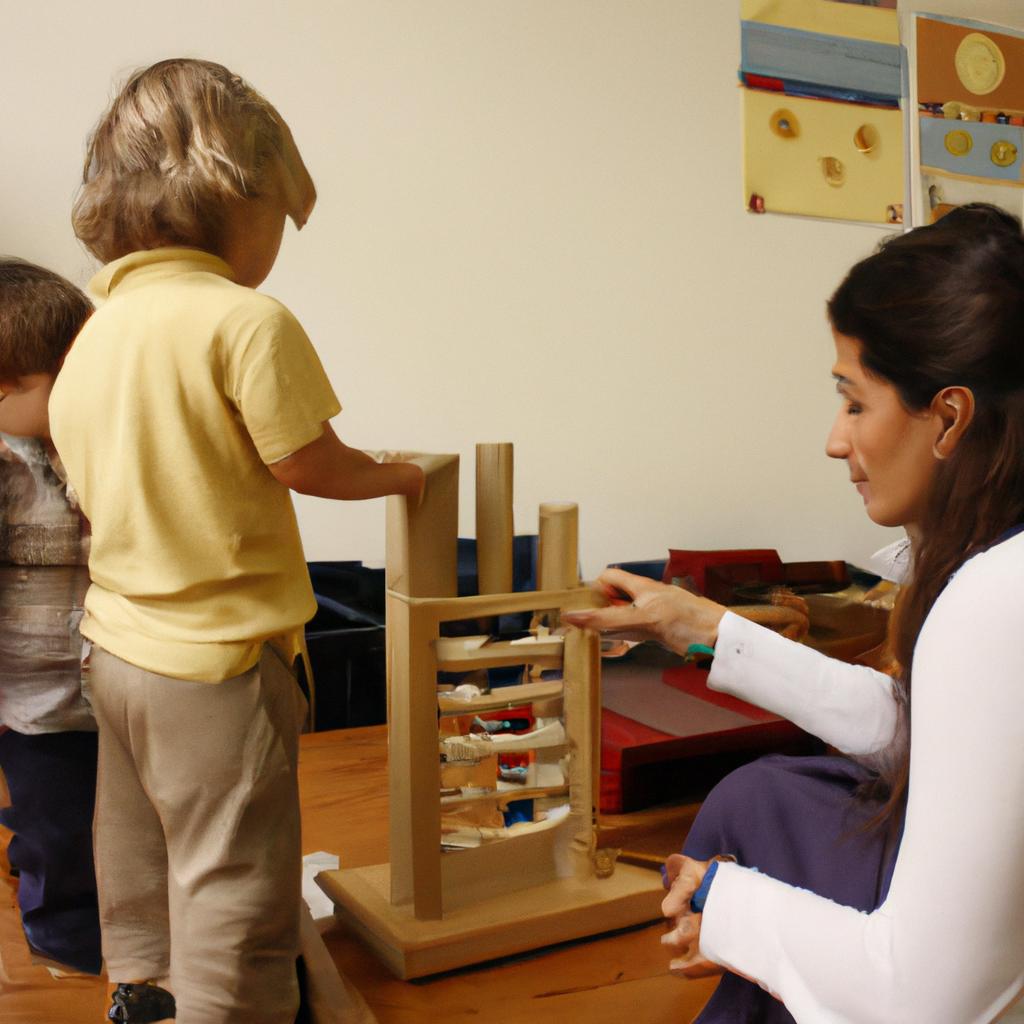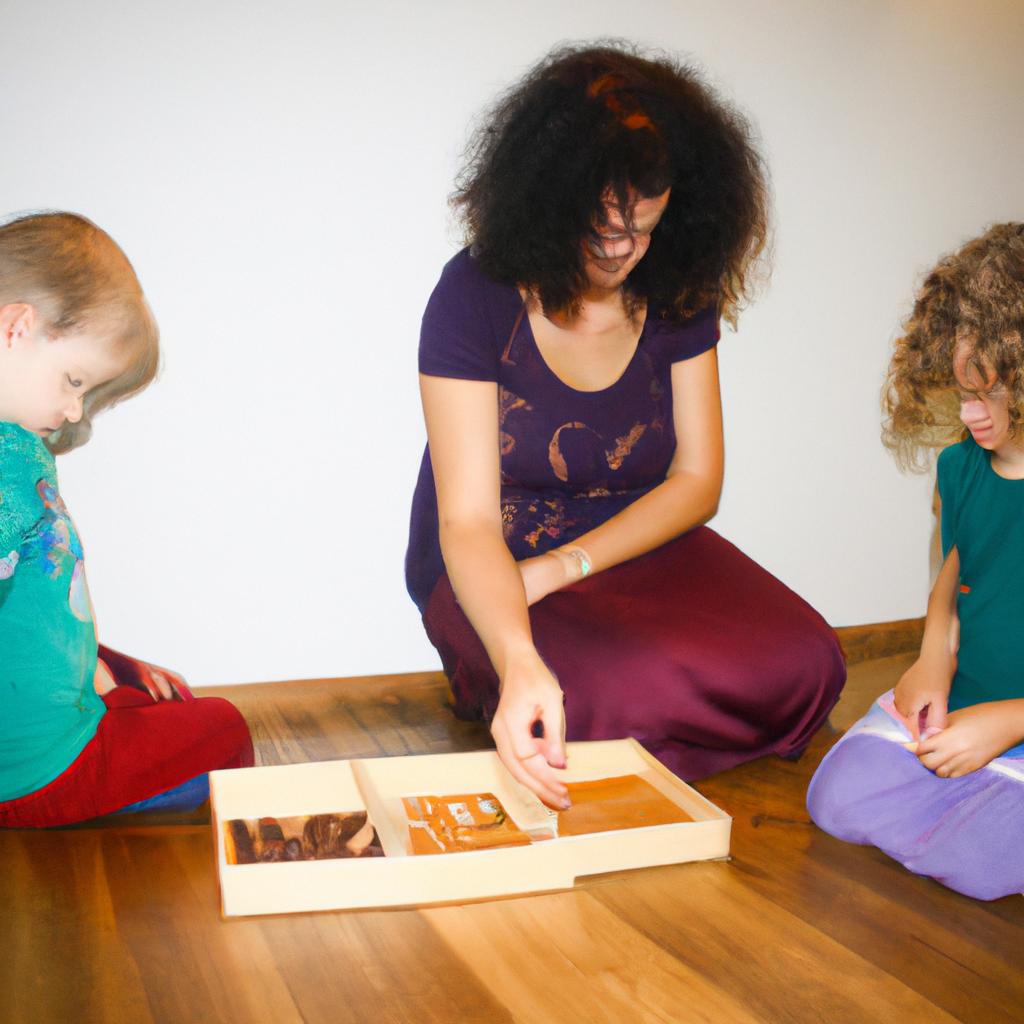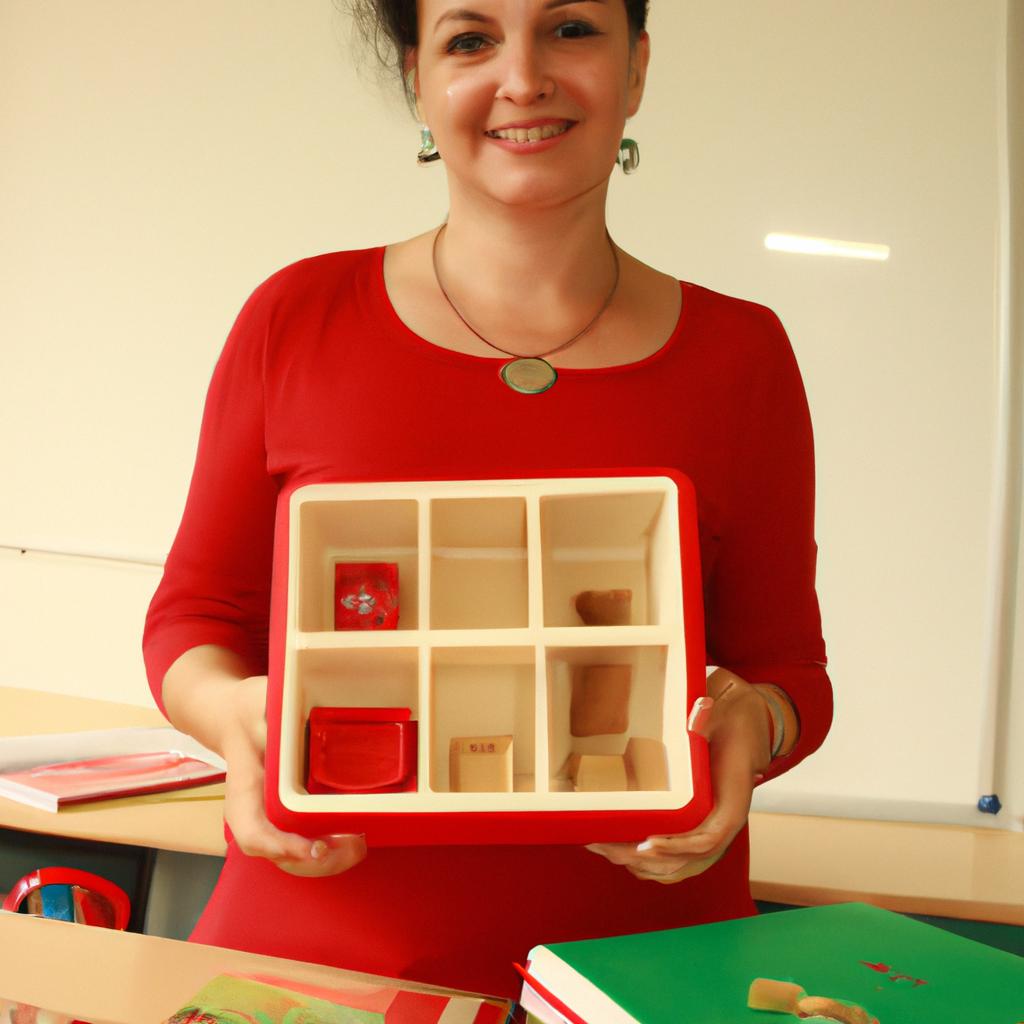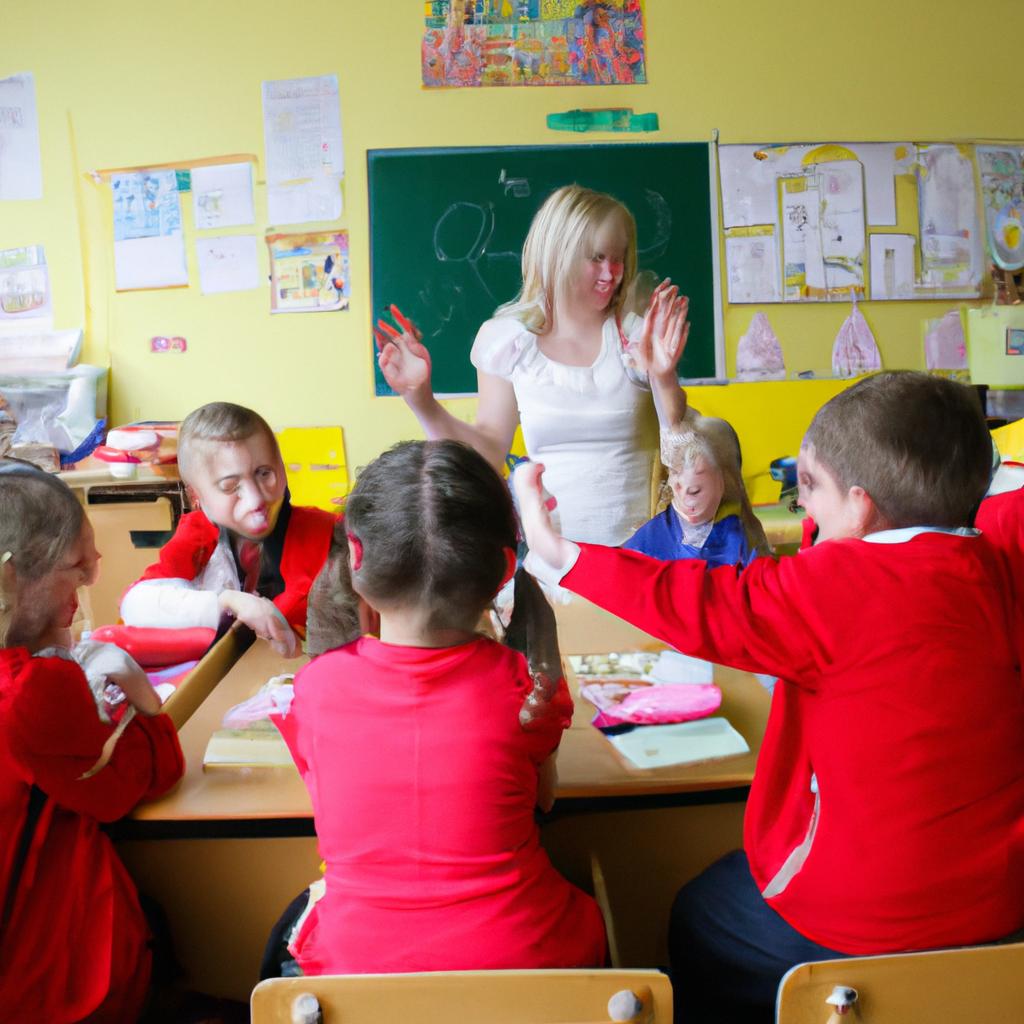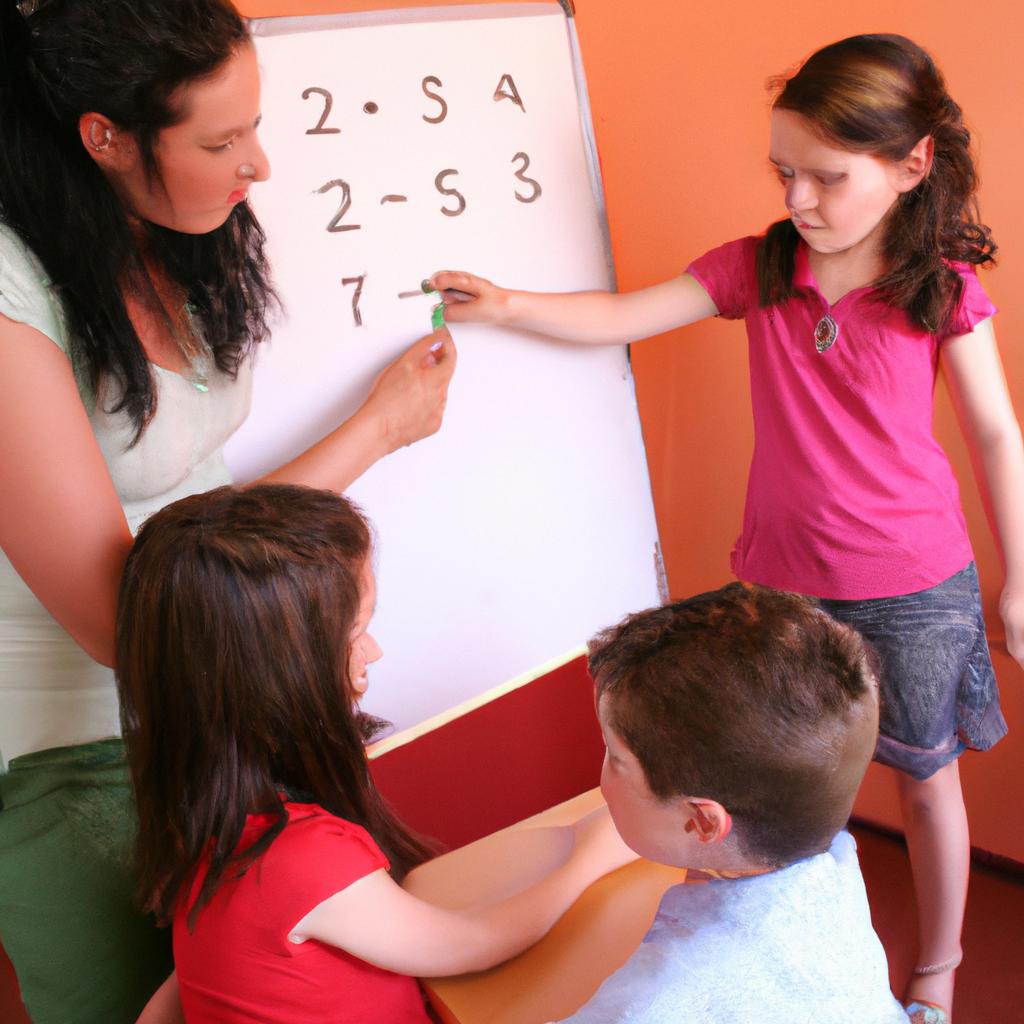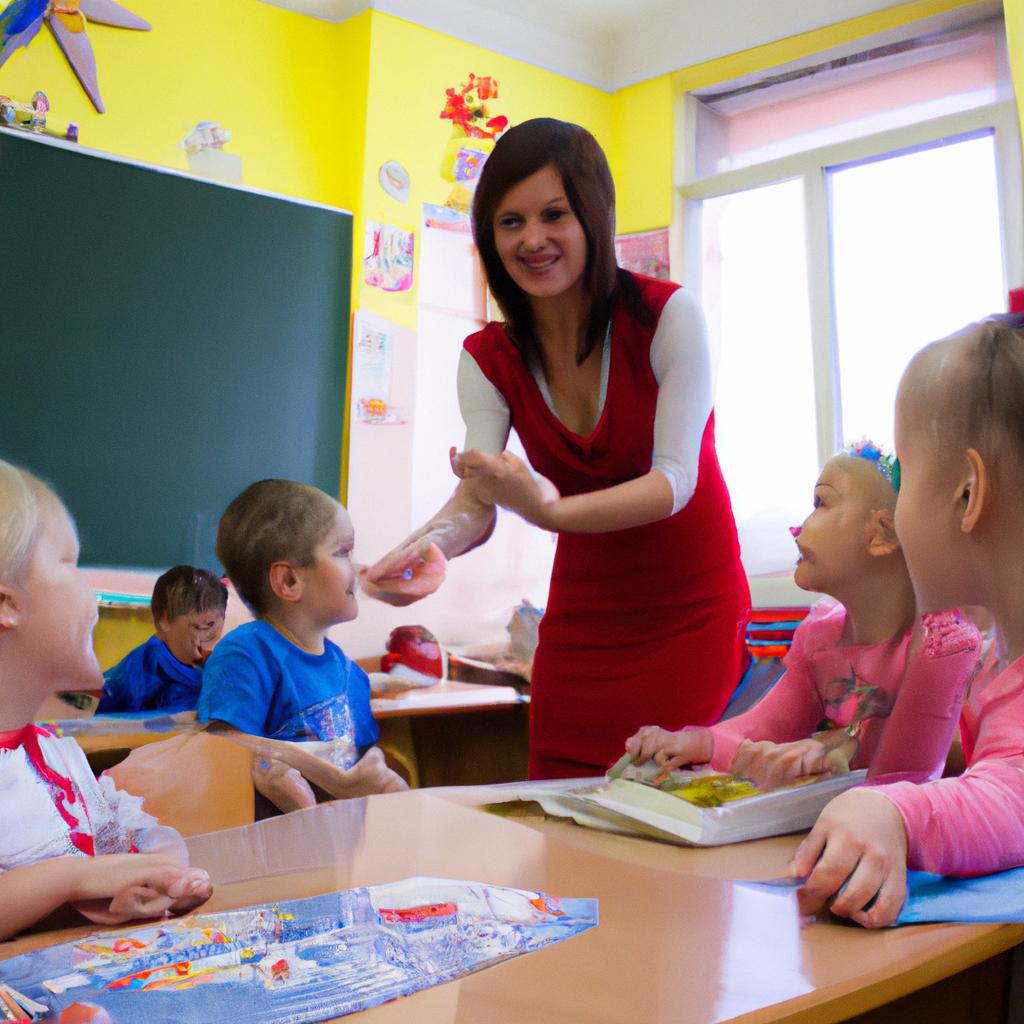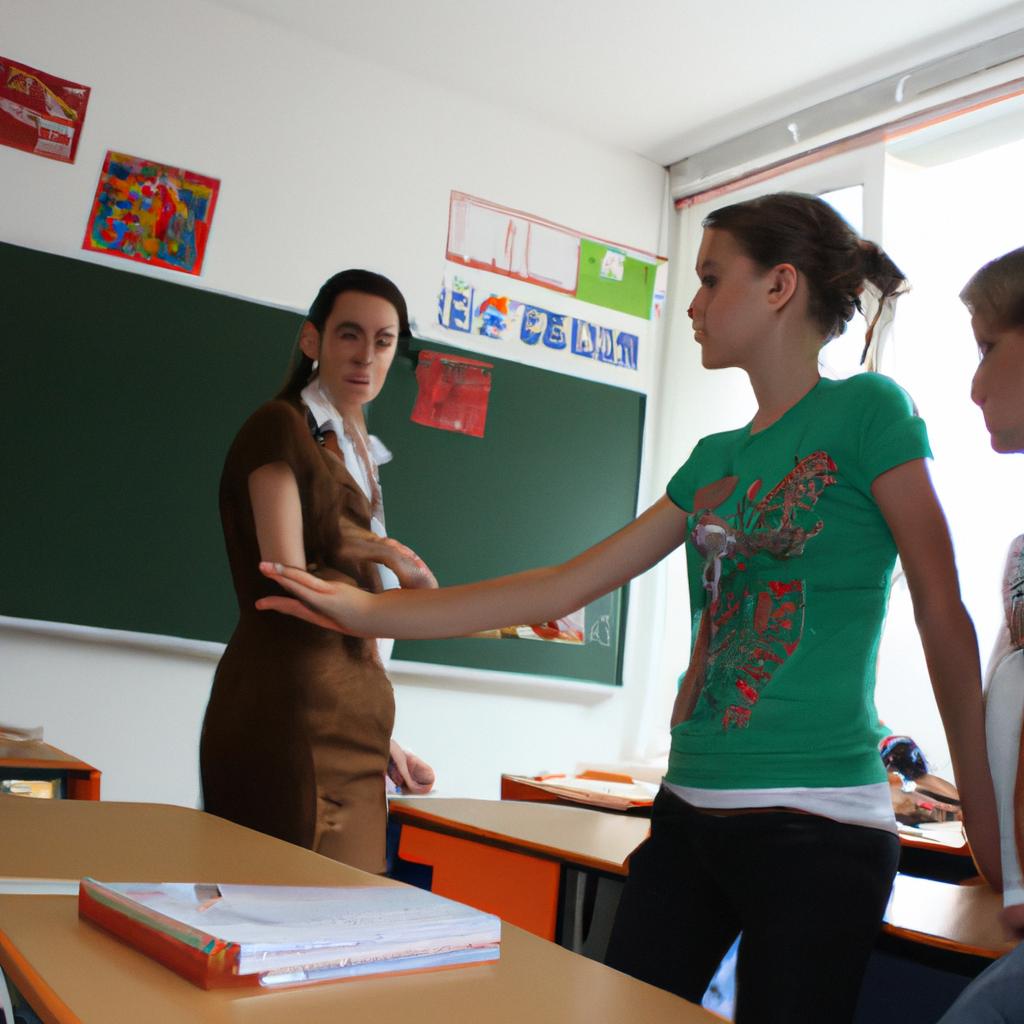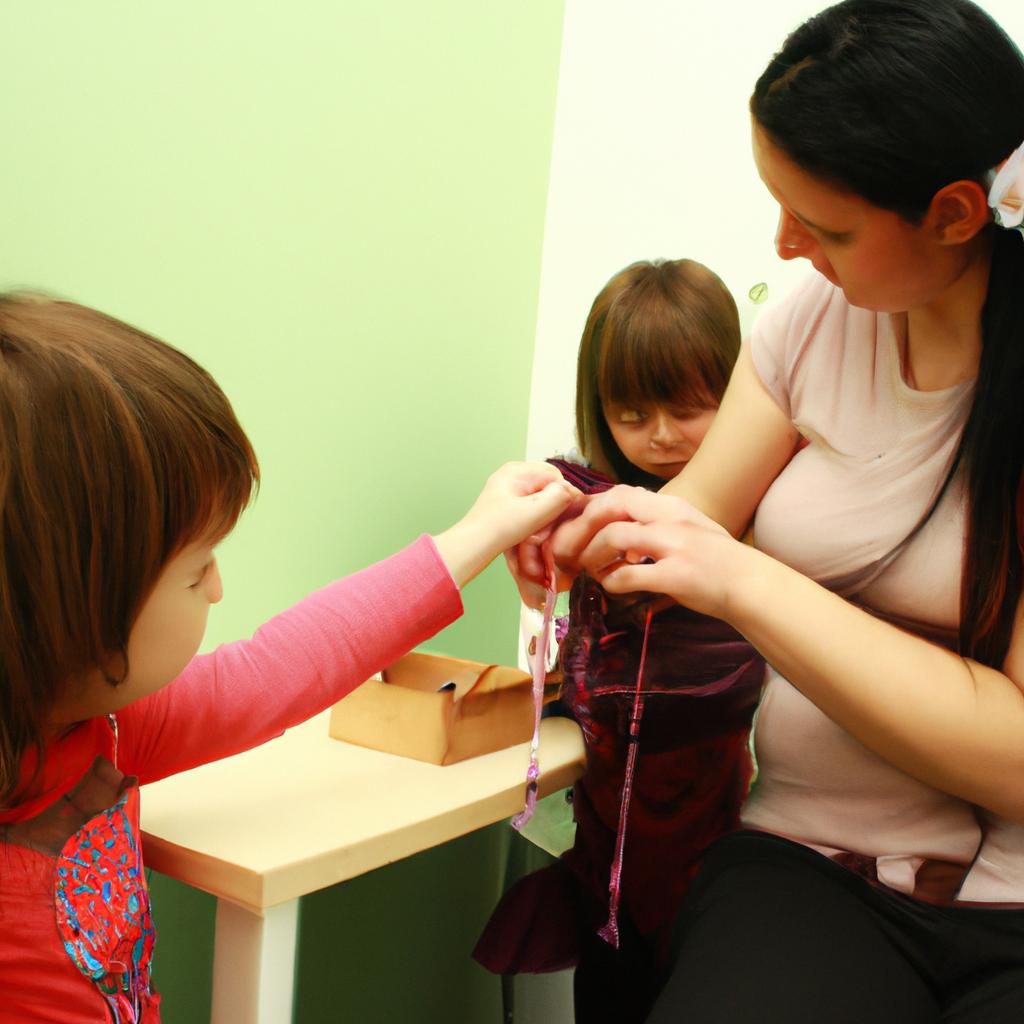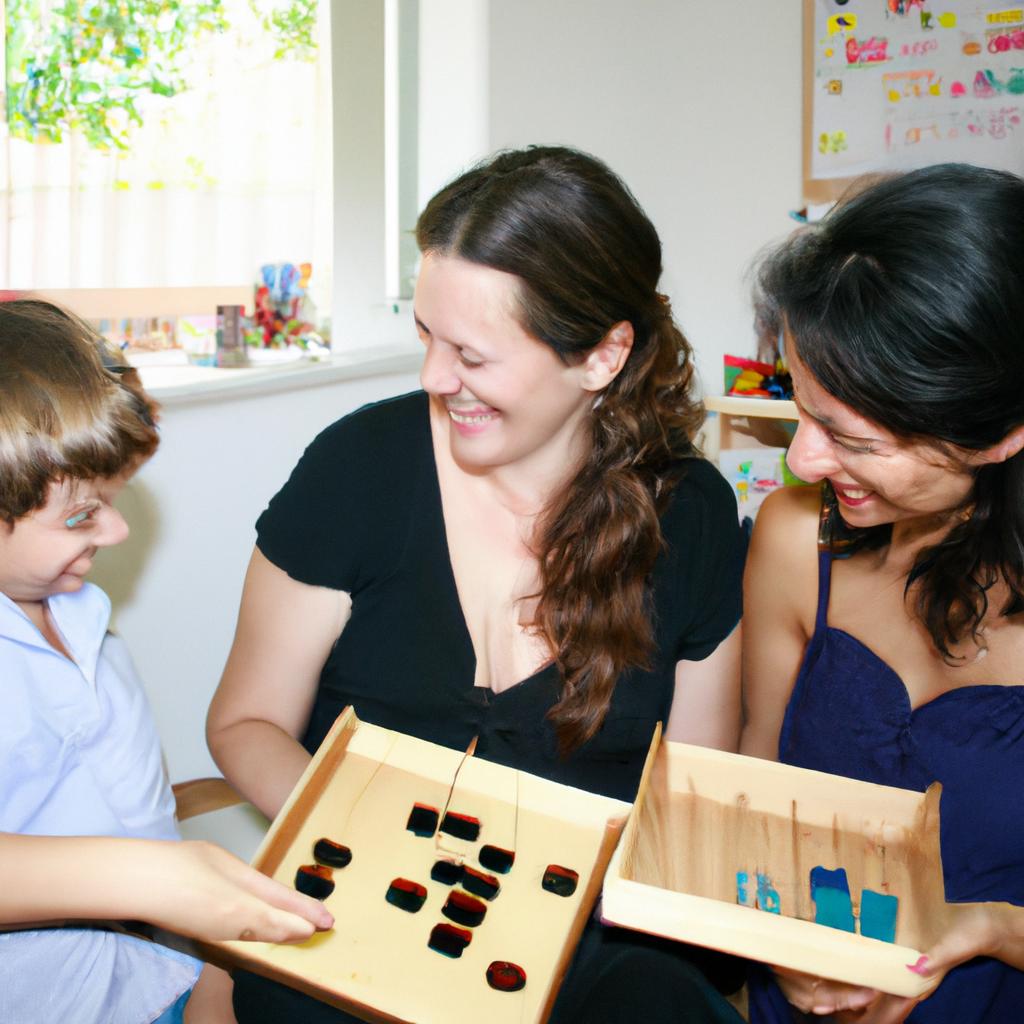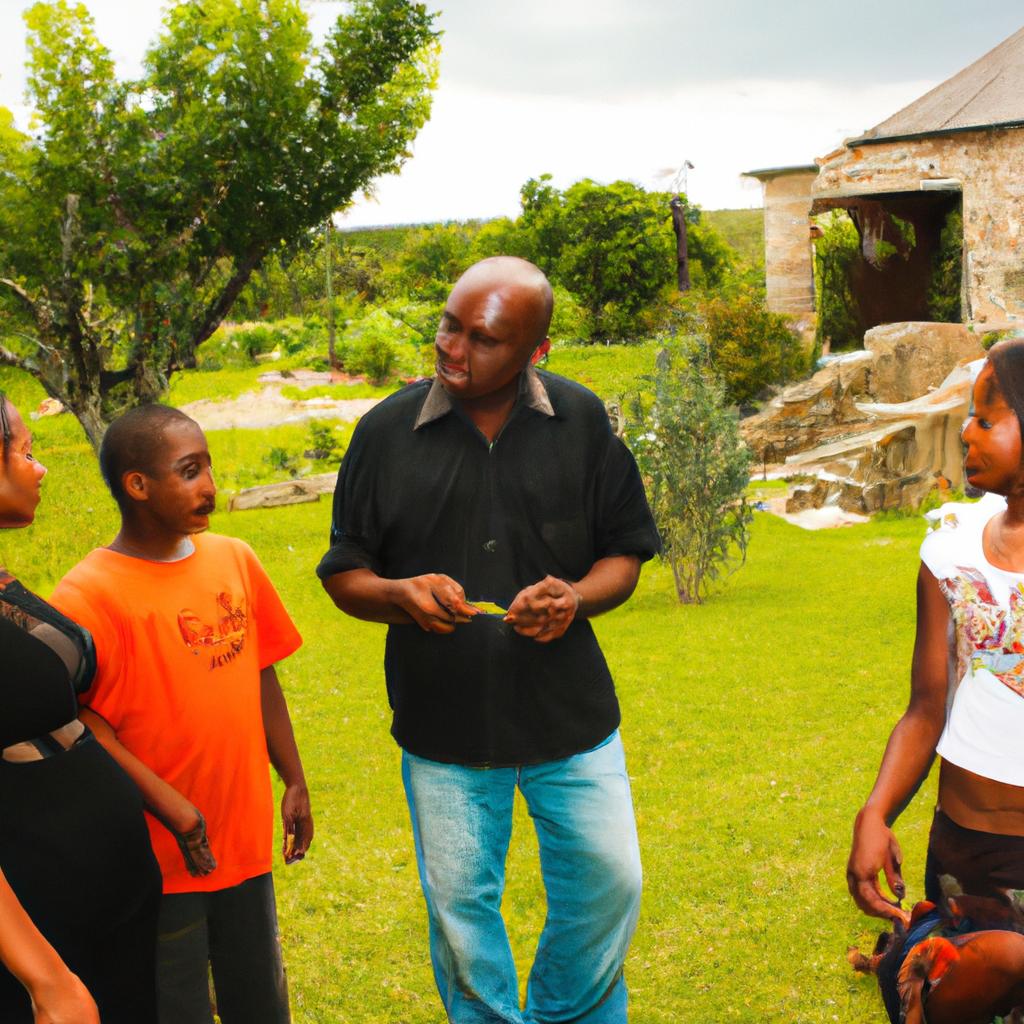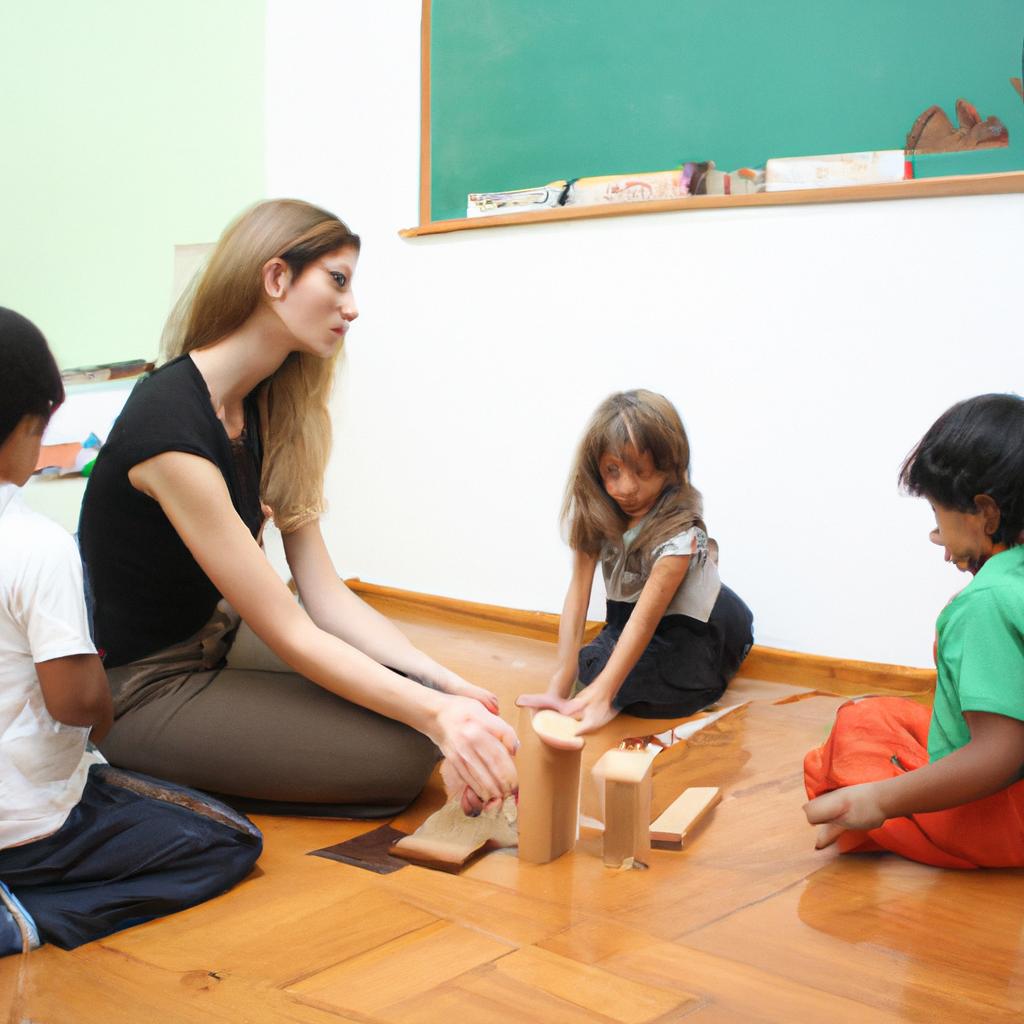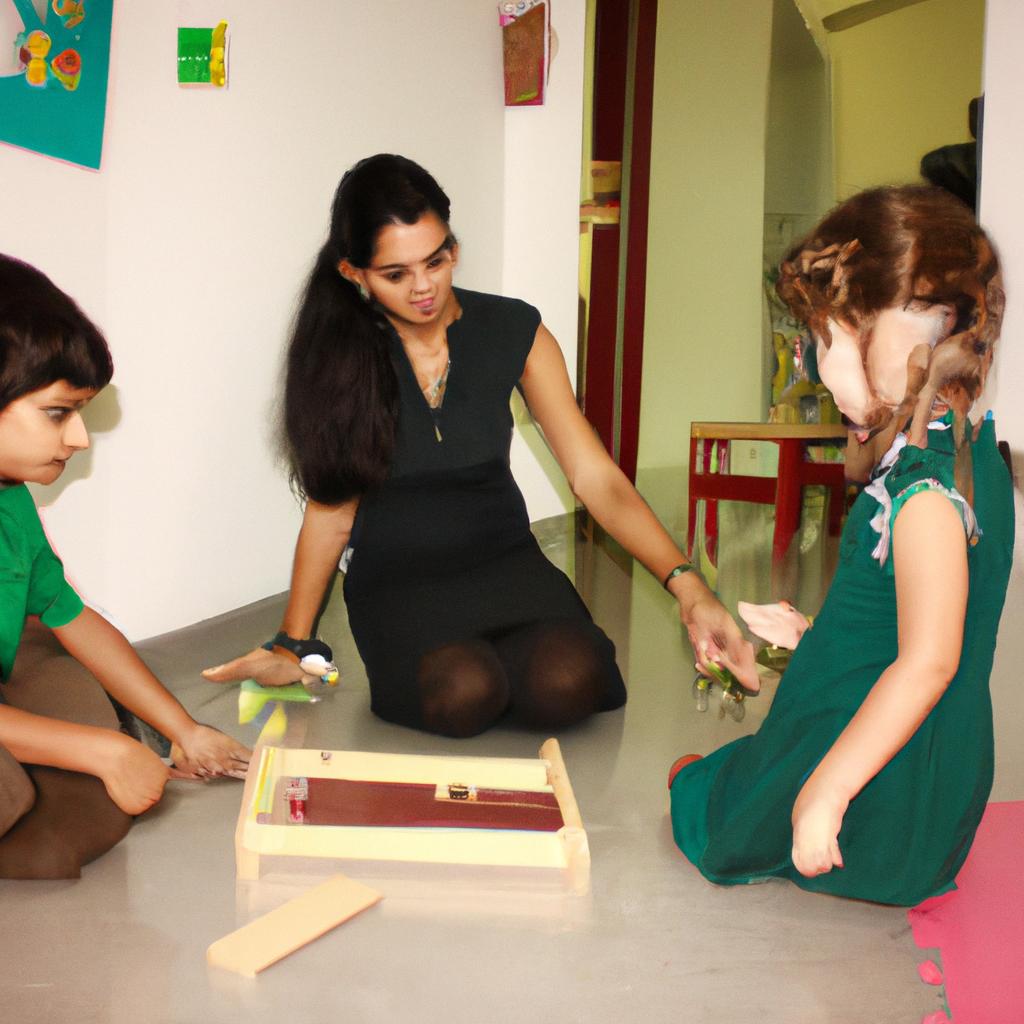In the field of education, various approaches have been developed to enhance learning experiences for children. One such approach is the Montessori method, which places a strong emphasis on sensorial materials as integral tools for educational development. These materials provide children with opportunities to engage their senses and explore the world around them in a hands-on manner. For instance, imagine a young child named Sarah who is introduced to a set of geometric shapes that she can feel and manipulate. Through this interactive experience, Sarah not only gains tactile knowledge but also develops her cognitive skills by understanding concepts such as shape recognition and spatial awareness.
The use of sensorial materials in a Montessori classroom serves multiple purposes beyond simply engaging a child’s senses. Firstly, these materials are designed to facilitate the exploration of abstract concepts through concrete experiences. By providing tangible objects that represent mathematical or scientific ideas, children are able to grasp complex notions more easily. Secondly, sensorial materials aid in developing concentration skills as they require focused attention from the child during manipulation and exploration. This aspect supports the overall goal of fostering independent learning within the Montessori framework. Lastly, these materials promote self-correction and problem-solving abilities as children learn through trial and error while working with them.
Overall, the integration of sensor materials in the Montessori method enhances children’s learning experiences by providing hands-on, concrete opportunities to explore and understand abstract concepts.
Sensory Education: Stimulating the Senses
Sensory education plays a crucial role in the Montessori approach to education, as it aims to stimulate and engage all the senses of children. By providing sensorial materials and activities, educators create an environment that encourages hands-on exploration and discovery. This section will discuss the importance of sensory education in fostering holistic development and provide an example to illustrate its effectiveness.
One key aspect of sensory education is its ability to enhance cognitive development. When children engage with sensorial materials, they are encouraged to observe, compare, classify, and analyze various attributes such as color, shape, texture, size, weight, and temperature. For example, imagine a classroom where students have access to different types of fabric samples. By touching and comparing these fabrics – from soft cotton to rough burlap – learners can develop their tactile discrimination skills while also learning about different textures.
Furthermore, sensory education helps cultivate concentration and focus among students. When children immerse themselves in sensorial activities like pouring water or sorting objects by size or color, they naturally enter a state of deep concentration. This sustained attention allows them to fully explore and understand concepts at their own pace.
To evoke an emotional response in the audience:
- Sensorial education fosters creativity by encouraging imagination through engaging with different materials.
- It promotes joy and enthusiasm in learning as children actively participate in hands-on experiences.
- It nurtures confidence and independence as students gain mastery over various tasks.
- It creates a sense of wonderment by enabling children to discover new things about the world around them.
In addition to these benefits, sensory education supports holistic development by addressing multiple domains: physical (fine motor skills), intellectual (cognitive abilities), social-emotional (self-regulation), linguistic (vocabulary acquisition), and even spiritual growth (appreciation for beauty).
| Benefits of Sensory Education |
|---|
| Enhances cognitive development |
| Cultivates concentration and focus |
| Fosters creativity and imagination |
| Supports holistic development |
In conclusion, sensory education is a fundamental component of the Montessori approach to education. By engaging children’s senses through sensorial materials and activities, educators create an environment that promotes cognitive development, concentration, creativity, and overall holistic growth.
Benefits of Sensorial Materials in Education
Transitioning from the previous section, where we explored how sensory education stimulates the senses, it is crucial to recognize the significance of sensorial materials in implementing the Montessori approach to education. These materials are carefully designed to engage children’s senses and promote their cognitive development. To illustrate this point, let us consider a hypothetical case study involving a group of preschoolers engaging with sensorial materials.
In this imaginary scenario, a group of four-year-old children enters a Montessori classroom equipped with an array of sensorial materials. Among them is a set of geometric solids, which consists of different three-dimensional shapes such as cubes, cylinders, and cones. As the children explore these objects through touch and manipulation, they begin to develop an understanding of shape, form, and spatial relationships.
The use of sensorial materials offers several benefits that enhance the learning experience for students:
-
Enhanced Sensory Development: By engaging multiple senses simultaneously – including sight, touch, hearing, and sometimes even smell or taste – children can strengthen their ability to perceive and interpret sensory information effectively.
-
Improved Concentration and Focus: The hands-on nature of using sensorial materials encourages children to concentrate on specific tasks for extended periods. This allows them to refine their attention skills while deepening their engagement with the material at hand.
-
Development of Critical Thinking Skills: Through exploring various concepts using sensorial materials, such as size discrimination or color grading exercises, children learn to analyze differences and similarities between objects systematically. This fosters critical thinking abilities essential for problem-solving later in life.
-
Encouragement of Independent Learning: Sensorial activities empower children by providing opportunities for independent exploration without constant adult intervention. They learn at their own pace while developing self-confidence and autonomy.
To further understand the impact of sensorial materials in fostering holistic development among young learners, refer to Table 1 for a visual representation of the benefits mentioned above:
Table 1: Benefits of Sensorial Materials in Montessori Education
| Benefit | Description |
|---|---|
| Enhanced Sensory Development | Engaging multiple senses simultaneously to strengthen perception and interpretation skills |
| Improved Concentration | Encouraging extended periods of focused engagement |
| Development of Critical Thinking Skills | Analyzing differences and similarities systematically |
| Encouragement of Independent Learning | Promoting self-confidence, autonomy, and learning at one’s own pace |
In essence, incorporating sensorial materials into the Montessori educational framework provides students with an experiential foundation for their cognitive development. By engaging children’s senses through hands-on exploration, these materials facilitate enhanced sensory development, improved concentration, critical thinking abilities, and independent learning. The role of sensorial materials is fundamental in cultivating well-rounded individuals who are prepared to navigate future academic challenges.
Transitioning smoothly into the subsequent section about “The Role of Sensorial Materials in Montessori Education,” we can now explore how these materials fit seamlessly within the broader framework of Montessori education.
The Role of Sensorial Materials in Montessori Education
Transitioning from the previous section, where we explored the benefits of sensorial materials in education, let us now delve into their role within Montessori education. To illustrate this further, consider a hypothetical scenario: Imagine a young child named Sarah who is beginning her journey through Montessori education. As she enters the classroom, she encounters various sensorial materials carefully arranged on shelves and tables.
The first aspect of the role of sensorial materials in Montessori education is to facilitate individual exploration and discovery. These materials are designed to engage children’s senses, allowing them to actively explore and manipulate objects while absorbing information about their properties and characteristics. For instance, Sarah might pick up a color tablets box and begin sorting them according to hue or shade. Through hands-on interaction with these materials, children like Sarah develop confidence in their abilities as they independently navigate their learning experiences.
Secondly, sensorial materials provide concrete representations of abstract concepts. In other words, they offer tangible ways for children to understand ideas that may otherwise be challenging to grasp solely through verbal instruction or visual aids alone. This helps bridge the gap between theoretical knowledge and practical understanding. For example, when presented with geometric solids such as cubes or spheres, Sarah not only sees but also feels their shapes and contours—enabling her to internalize spatial relationships more effectively.
Lastly, incorporating sensorial materials fosters the development of important cognitive skills essential for academic success. Engaging with these materials stimulates critical thinking abilities such as observation, comparison, classification, and problem-solving—all vital components of higher-order cognitive processes. By engaging with sensorial activities like matching colors or grading sizes of cylinders based on diameter or height variations, children sharpen their analytical skills while honing their attention to detail.
In conclusion (as per your request), developing cognitive skills through sensorial materials plays a fundamental role in fostering holistic educational growth among students within the Montessori framework. Now let us dig deeper into how these materials specifically contribute to the cognitive development of children.
Developing Cognitive Skills through Sensorial Materials
Building upon the foundational role of sensorial materials in Montessori education, their effective use can lead to the development of essential cognitive skills. By engaging children in purposeful exploration and manipulation of these materials, they are provided with opportunities to enhance their cognitive abilities and develop a deeper understanding of concepts. This section explores how sensorial materials contribute to the cognitive growth of students.
To illustrate the impact of sensorial materials on cognitive development, let us consider an example. Imagine a preschool classroom where children are given access to various geometric shapes made from different textures such as wood, metal, and fabric. Through hands-on interaction with these materials, children not only learn about spatial relationships but also sharpen their tactile discrimination skills. They become more adept at identifying differences between surfaces and recognizing patterns based on touch alone. This active engagement enables them to make connections between abstract concepts and concrete experiences.
The utilization of sensorial materials in Montessori classrooms fosters several key cognitive skills among learners:
- Discrimination: Children refine their ability to differentiate between similarities and differences in size, color, shape, texture, weight, taste or smell.
- Classification: By organizing objects based on shared characteristics, students develop the capacity to categorize information effectively.
- Seriation: Manipulating graduated series of objects allows young minds to understand relative sizes or quantities and arrange items in sequential order.
- Problem-solving: The open-ended nature of many sensorial materials encourages critical thinking as children explore multiple solutions or approaches.
Sensorial activities engage children by:
- Stimulating curiosity
- Encouraging independent exploration
- Fostering a sense of accomplishment
- Promoting self-confidence
Table (3 columns x 4 rows):
| Cognitive Skill | Description | Example |
|---|---|---|
| Discrimination | Differentiating between attributes or qualities of objects | Identifying differences in taste through a blindfolded game |
| Classification | Organizing information into groups based on shared characteristics | Sorting objects by color, shape, or texture |
| Seriation | Arranging objects in sequential order based on size, weight, or quantity | Placing blocks from smallest to largest |
| Problem-solving | Finding solutions to challenges using critical thinking | Constructing complex patterns with various geometric shapes |
In conclusion, the incorporation of sensorial materials within the Montessori approach facilitates cognitive development among young learners. Through engaging experiences and purposeful exploration, children develop important skills such as discrimination, classification, seriation, and problem-solving. These activities not only stimulate curiosity but also foster independent thinking and a sense of accomplishment. As we delve further into the educational benefits of sensorial materials, let us now explore how they contribute to enhancing fine motor skills.
By honing their cognitive abilities through sensorial materials, students also gain opportunities for refining their fine motor skills.
Enhancing Fine Motor Skills with Sensorial Materials
In the previous section, we explored how sensorial materials play a vital role in developing cognitive skills in children. Now, let us delve further into this topic by examining specific ways in which these materials enhance a child’s ability to think critically and problem solve.
One example of how sensorial materials foster cognitive development is through the use of geometric solids. By manipulating these three-dimensional objects, children not only develop their spatial awareness but also strengthen their reasoning abilities. For instance, when presented with different geometric shapes, children can explore concepts like symmetry, congruence, and transformational geometry. This hands-on experience allows them to grasp abstract mathematical principles more easily.
Furthermore, engaging with sensorial materials provides children with opportunities to practice classification and seriation skills. Through activities such as sorting objects by color or size, children learn to identify similarities and differences among various items. This process encourages logical thinking and helps them understand fundamental concepts related to categorization and organization.
To illustrate the positive impact of sensorial materials on cognitive development, consider the following bullet points:
- Engaging with sensory-rich learning experiences stimulates neural connections.
- Hands-on exploration promotes active engagement and memory retention.
- Multisensory activities enhance information processing and integration.
- The tactile nature of sensorial materials facilitates kinesthetic learning.
Additionally, incorporating a visual aid like the table below can evoke an emotional response from the audience:
| Sensory Material | Benefits |
|---|---|
| Puzzle boards | Develops problem-solving skills |
| Sound cylinders | Enhances auditory discrimination |
| Smelling bottles | Stimulates olfactory senses |
| Taste testing | Fosters gustatory exploration |
By utilizing sensory-rich teaching methods that incorporate diverse materials, educators have the power to create an enriching environment for students’ cognitive growth.
As we move forward in our exploration of Montessori’s sensorial approach, let us now shift our focus to the importance of creating a rich sensorial environment in the classroom.
Creating a Rich Sensorial Environment in the Classroom
Enhancing Fine Motor Skills with Sensorial Materials has been a crucial aspect of the Montessori approach to education. By engaging children in activities that require precise hand movements, they not only develop their fine motor skills but also enhance their overall cognitive development. In this section, we will explore how educators can create a rich sensorial environment in the classroom to foster an optimal learning experience for students.
Imagine a classroom where various sensorial materials are thoughtfully arranged and easily accessible to children. One such example is a set of geometric solids placed on a shelf, inviting the young learners to explore different shapes and sizes through touch and visual observation. As they manipulate these objects, they refine their sense of touch and deepen their understanding of spatial relationships.
To further enrich the sensorial experience, educators can incorporate the following strategies:
- Introduce tactile materials: Providing textured fabrics or surfaces allows children to engage their sense of touch while promoting sensory exploration.
- Incorporate scents: Utilizing scented materials or introducing natural smells into the environment can stimulate olfactory senses and evoke emotions.
- Offer auditory stimuli: Including musical instruments or sound-making toys encourages children’s engagement with sounds, fostering auditory perception and coordination.
- Create visual displays: Displaying colorful artwork or incorporating visually stimulating materials helps develop visual discrimination skills and aesthetic appreciation.
In order to illustrate these strategies more effectively, let us consider a table that showcases examples of each strategy mentioned above:
| Strategy | Example |
|---|---|
| Tactile materials | A basket filled with fabric swatches featuring varying textures |
| Scented materials | Small jars containing herbs or flowers with distinct fragrances |
| Auditory stimuli | Musical instruments like tambourines or xylophones |
| Visual displays | Colorful paintings displayed on easels |
By implementing these strategies and providing diverse sensorial experiences in the classroom setting, educators support children’s holistic development and facilitate their engagement with the learning process.
In summary, creating a rich sensorial environment in the classroom is an essential element of the Montessori approach to education. By incorporating tactile materials, scents, auditory stimuli, and visual displays, educators can enhance students’ sensory exploration and promote cognitive development. Through these strategies, children are encouraged to actively engage their senses, fostering a deeper understanding of the world around them.

